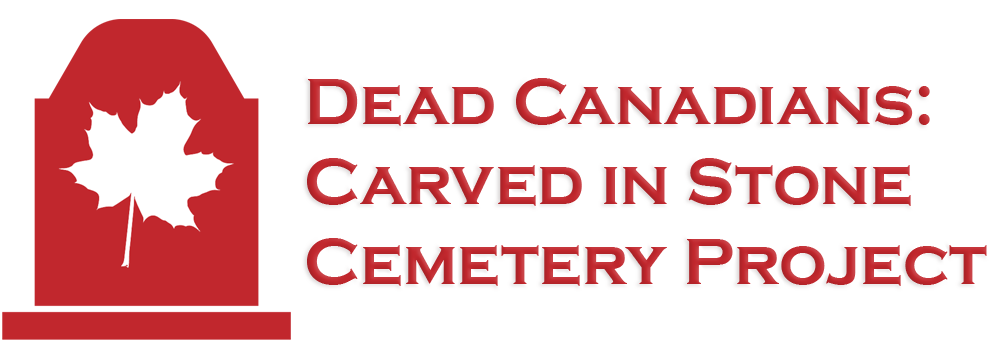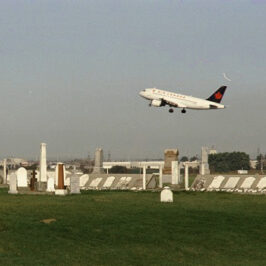Earlier this year, we travelled north to Capreol for a family wedding. We weren’t in town very long and I am confident that this little northern rail community has more to explore, but one story we did encounter was that of two deadly train derailments in 1930 that are linked to a large, and possibly empty, burial plot in the Capreol cemetery.
It had been raining incessantly for days when, on June 25, 1930, at 10:30 pm ‘Passenger Train No. 4,’ running from Winnipeg to Toronto, derailed near Milnet into the Vermilion River. Many passengers were injured and five were killed, including four children. Two passenger cars, a tourist car and a colonist car, from the eastbound CN express plunged in a V-shape into the Vermilion River from an embankment curve that had slumped due to the heavy rains. The engine, coal tender, baggage car and observation car remained on the rails. Communication was poor that night due to many telephone poles and wires being washed out; the engine was uncoupled and the engineer was sent on alone to Capreol to get help.
A relief train was immediately sent from Capreol to the scene of the accident, filled with railway superintendents, doctors and nurses. The relief train arrived back in Capreol at 1:15 am with the injured who were housed in a makeshift hospital in the town’s YMCA. Completed in 1921 and serving as a rooming house for CNR workers and a recreational centre for Capreol’s residents, the building was closed in 1978 and demolished in 1979. Those not badly injured were taken in by generous Capreol residents until a relief train with day coaches, sleeping cars and a dining coach could arrive from Toronto many hours later on June 27, 1930.
The dead killed in the wreck, all from drowning, of Passenger Train No. 4 were:
– Lonore and Arthur Gilbert, ages 7 and 4, the youngest children of Percy Gilbert and Mary Hunter of Fairmount, Saskatchewan, were drowned as they slept. Their bodies were taken home to Kindersley, Saskatchewan for burial and they are buried together in the family plot. Their brother Frank died just two years later, age 15; another tragedy for the family. Other siblings Harry, Jack, Gwyneth and Phyllis all lived to adulthood. It is currently unknown if any of the other children were on board the train in 1930.
– Helen Mary Wedderburn (frequently mistranscribed as Nedderburn), age 3 1/2, daughter of John Wedderburn and Mary Alice Joyce, who had been traveling from Saskatoon with her mother to attend the funeral of mother’s sister in Boston, Esquesing Township near Milton in southern Ontario. Helen Mary is now buried with her aunt in the Boston Church Cemetery.
– Giselle Brussiere, age seven-months, daughter of Mr. & Mrs. George Brussiere. The family, with three young children, were moving from Elsas to Sturgeon Falls and the children had been asleep when the train plunged into the water. The father pulled the two older children to safety and the mother had held her baby tight in her arms as they made their way safety, only discovering once they were clear of the wreck that the infant was dead in her arms.
– Ben Giles, age 60 from Lloydminster, Saskatchewan, whose body wasn’t found until June 30. Although his body was found at the same time as Helen Mary Wedderburn, he had been travelling alone and his family had been unsure if he had been on the train or not. Other passengers had reported that a “old man” they had seen on the train was missing but initial searches turned up nothing. His body was returned to Lloydminster for burial.
Just as the citizens of Capreol were dealing with the fallout of this one disaster, a freight train tipped over on June 27, 1930, also the victim of railway embankment slump caused by the heavy rains. Named for the location of the accident, the Crerar derailment was also a CN train: Freight Train No. 401, heading westbound. Many of the crew were residents of Capreol, including two who were killed. Also on board this train were eight “trainhoppers” who had boarded illegally and were all found deceased. Their death records include very little information but give us a few tiny clues about their lives: all male; Lativian, Finnish, French. All eight deaths are described as “Multiple injuries. Rolled in train wreck.” Their graves have no markers. The inquest into this second disaster was conducted in conjunction with the Milnet/Vermillion River disaster, forever linking these two deadly rail disasters in northern Ontario history.
Tragic as the whole situation was, there have been other rail disasters. What continues to resonate about the 1930 disasters? For one, a white cross in the Capreol Cemetery, with the names “Milnet” and “Crearar” under “RIP” and “CNR Train Wrecks 1930”, which are easily mistaken as surnames indicating possible burials below. Yet, despite occupying a significant sized plot in the cemetery, the plot is rumoured to be empty.
As news spread about the train wrecks, residents of the town prepared a large pit in the cemetery to bury the anticipated high numbers of dead. This wooden cross was erected to the memory of the train wrecks. But the deceased crew members were buried in their own plots, two of them in Capreol, and the eight trainhopping men from the Crerar disaster were all buried in Sudbury. The Gilbert children, Helen Mary Wedderburn and Ben Giles were all buried with family and/or in their home communities, not Capreol. The only possible burial in the large plot may be that of infant Giselle Brussiere whose funeral was held at the YMCA shortly after the accident, and whose burial at the Roman Catholic Cemetery was reported in the newspaper. Her death record indicates Capreol as her burial location and there is only one cemetery in Capreol so she must be here. However, the exact location of her tiny coffin that travelled from the YMCA to the cemetery in the back of a car loaned by a caring Capreol resident, is unknown.



Leave a Reply